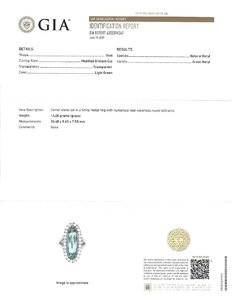You are using an out of date browser. It may not display this or other websites correctly.
You should upgrade or use an alternative browser.
You should upgrade or use an alternative browser.
A Sea Green Aquamarine
- Thread starter prs
- Start date
- Joined
- Dec 26, 2017
- Messages
- 1,883
Thank you!I love aquas with the blue-green sea water color. The bright blues look like topaz to me. Your stone isstunning.
I think this was discussed in another recent thread, but in her written report, the appraiser we use insisted on describing the stone as "green beryl" rather than aquamarine.
- Joined
- Sep 20, 2008
- Messages
- 25,228
- Joined
- Dec 26, 2017
- Messages
- 1,883
Yes and yes.Was the appraiser a graduate gemologist?
Did they run tests on the stone?
As I understand it the the only difference between green beryl and aquamarine is the color. Apparently there are some perfectionists in the trade who believe that if a gem from the beryl family is predominantly green, it should be classified as green beryl. Obviously those perfectionists are not gemstone vendors!
- Joined
- Sep 20, 2008
- Messages
- 25,228
From what I hear, if the stone is blue or greenish blue and colored by iron, it is aqua. If it’s green and colored predominantly by chromium, then emerald, and if green and only colored by vanadium, green beryl, and I don’t know what the chromophores are for heliodor, morganite, or bixbite but they’re the other colors of beryl. Then goshenite is colorless beryl. Goshenite is often falsely sold as aqua.Yes and yes.
As I understand it the the only difference between green beryl and aquamarine is the color. Apparently there are some perfectionists in the trade who believe that if a gem from the beryl family is predominantly green, it should be classified as green beryl. Obviously those perfectionists are not gemstone vendors!
Nice ring, no matter the moniker. Enjoy!
- Joined
- Sep 20, 2008
- Messages
- 25,228
No, they’re emerald if the primary chromophore (chemical responsible for color) is chromium. Green beryl is colored by vanadium which is why they have barely any to no inclusions. Emeralds tend to be included because chromium puts stress on the crystal.So are emeralds not "emeralds" and are really 'green beryl"- technically?
Zambian emeralds are colored by both chromium and vanadium, but the chromium is still present.
I have a true green beryl. It’s as clean as a whistle.
It should also be noted that extremely pale emeralds typically have less inclusions, because they have much less chromium, and therefore the color isn’t as saturated or rich. They should be priced very low.
The real rare stuff that’s super hard to come by is very dark, saturated material that is also clean with no enhancement . This is because the crystal is so stressed by the extra chromium, but it’s very clean. Those are the emeralds you see at the big auction houses.
Last edited:
- Joined
- Dec 26, 2017
- Messages
- 1,883
- Joined
- Sep 20, 2008
- Messages
- 25,228
- Joined
- May 11, 2012
- Messages
- 9,801
- Joined
- Sep 20, 2008
- Messages
- 25,228
No, green beryl can sometimes be more expensive than aquamarine.So is it cheaper now that's it's not an aquamarine?
- Joined
- Dec 26, 2017
- Messages
- 1,883
DW asked the same question!So is it cheaper now that's it's not an aquamarine?
Good answer T L!!!No, green beryl can sometimes be more expensive than aquamarine.
AV_
Ideal_Rock
- Joined
- Aug 5, 2018
- Messages
- 3,889
Share:
Featured Topics
Past, Present, Future: The Meaning of Three-Stone Engagement Rings
Past, Present, Future: The Meaning of Three-Stone Engagement Rings - 04/14




300x240.png)